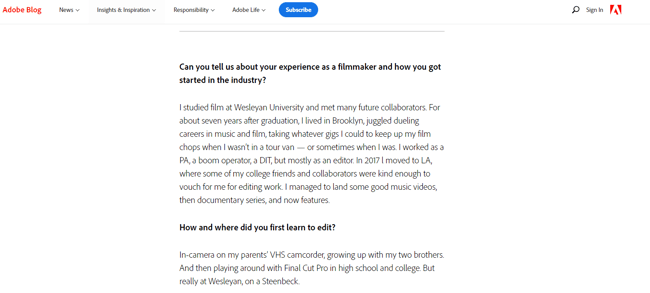Google loves its acronyms. In late 2022, the search giant added an extra wrinkle to theirSearch Quality Rater Guidelines andintroduced “Experience” to their existing Expertise, Authoritativeness, and Trust (E-A-T) framework.

This addition was part of Google’s ongoing effort to help websites provide users with more helpful, relevant information. E-E-A-T, or “Double-E-A-T,” now emphasizes the importance of including relevant first-hand experience with any subject matter.
What does it mean for publishers? We’ll cover that and more below.
Understanding E-E-A-T Guidelines
Each part of E-E-A-T is essential for great content:
- Experience: Real-world or first-hand experience with the topic.
- Expertise: Extensive formal training or real-world experience.
- Authoritativeness: Certification or the ability to be seen as an authority on a given topic.
- Trust: The overarching element that all the above seek to satisfy.
How does E-E-A-T impact SEO and content rankings? Well, it’s not technically aranking factor but it can affect how your content ranks in search.
The simplest way to answer this question is that content that ranks well – that satisfies the E-E-A-T part of Google’s Search Quality Rater Guidelines – meets the following parameters:
- It’s helpful content.
- Experts created it.
- It’s posted on an authoritative site.
- It’s trustworthy.
- It sees regular updates.
Google’s embrace of experience dovetails nicely with its existing guidelines and approach to providing users with extra details to answer their questions more accurately.
Consider Google’s example: There’s a big difference between looking for someone to do your taxes and looking for reviews of tax prep software. You want different information.
Google doesn’t see adding experience to the search equation as a new idea. Instead, it’s looking through the lens of understanding the nuance of user search habits – i.e. how and why people are looking for information.
This means that writers who rely heavily on research may need to push further and include quotes from people with experience. Sometimes, that might involve giving full authorship to trusted voices with the chops to back up the written or visual content.
Of course, there’s no magic bullet that will help your content rank well. But meeting the above guidelines – either on your own or with the help of an agency that understands them – can make a big difference in your results.
How to Apply E-E-A-T In your Content Creation Process
Expertise
Expertise shows the degree of knowledge your content displays. To apply that expertise, your content should:
- Provide accurate and up-to-date information. That includes citing reputable sources and studies.
- Highlight credentials, experience, and achievements.
- Provide in-depth analysis and thought leadership on industry trends and topics. Go deeper and present information beyond the “Subject Matter 101” type of blog content when you can.
- Leverage user-generated content from qualified users who know their stuff.
For examples of how expertise helps content shine, look at the articles from insurance industry leader,Policygenius. Their content usually features a by-line from an expert who has either written or reviewed it.

Experience
Experience is the newest addition to the classic E-A-T concept, but it doesn’t require a full pivot from your existing efforts.
It just refers to the writer’s first-hand experience with the topic. What’s the best way to show that experience? Try the following:
- Have a subject matter expert (SME) write or review your content for accuracy.
- Use quotes and insights from product specialists or experts to support other content.
- Collaborate with other industry experts outside of your business. Think of interviews with industry leaders or co-authored blog posts.
Take Adobe as an example. Their content strategy involves collaborating with creatives who use their products to write Q&A style blog posts. Direct quotes from filmmakers, photographers, and editors demonstrate first-hand experience with Adobe products.

Another example is pet supply company Chewy. They weave experience into their content byincluding quotes and insights from vets or various animal experts.

Authoritativeness
Brand recognition isn’t the only measure of authority. Making influential friends works, too.
One of the best ways to represent authority is to create a robust digital PR campaign for your content and site, including backlinks. Building a solid online presence involves more than just publishing hundreds of posts.
Network and collaborate with other experts and influencers, and don’t forget the importance of endorsements and positive reviews from real-life users of your product or service.
Looking for examples? Think about websites that have been around for a long time or have quickly built up their reputations. Maybe it’s the pest library from a company like Orkin.

Another good example is financial wellness tips from the experts atNerdWallet.

Need more examples? Consider the following:
Taylor Swift’s Eras Tour website is the primary source for all your ticketing and merch info.

The USDA’sinformation on beef grades is the most accurate source because they set the guidelines.

Trustworthiness
Having lots of content that can’t be trusted might be worse than no content at all.
Content is only good if you can trust it. That means it must be current, credible, and accessible. The best way to showcase this credibility is to keep the following in mind as you create your content:
- Be transparent and honest.
- Offer secure, user-friendly website experiences on both mobile and desktop. It’s 2023, after all. All users should have a similar experience no matter their device. That includes focusing on accessibility regarding images.
- Maintain a consistentbrand voice across all your content formats, not just the written ones.
- Evaluate and update your content often to ensure it’s accurate, relevant, and informative.
Some of the best websites that apply trustworthiness to their content regularly update it.Wirecutter, for example, is a New York Times-owned reviews site that marries experience, expertise, and trust.
They routinely examine new products and revise their lists to compare the most recent models.

Their comments section is also a fantastic home to learn about people’s experiences with the reviewed and recommended items.
What Following E-E-A-T Can Accomplish
My agency,NP Digital, recently had the opportunity to put our understanding of E-E-A-T guidelines to the test.
We worked with one client, who previously relied exclusively on user-generated content. Because a lot of the content was deemed spammy, irrelevant, and low-quality, it was impacting their search rankings.
We worked with this client to take ownership of their organiccontent strategy with a comprehensive content hub.
Within seven months, we supplied them with more than 450 pieces of fresh content while ensuring our content supported queries with high search demand and adhered to best practices for SEO and E-E-A-T. What happened next?
We saw exciting success within months, including the following benchmarks:
- 1.6 million average monthly organic impressions from our newly developed content, a 32% increase over UGC pages.
- A 28% increase in organic clicks, surpassing their previous UGC pages in under six months.
- Almost 7,000 new backlinks to the pages we created, boosting their domain authority by 28%.
- A 20% increase in the total number of keywords ranking in the first three positions on Google.
The takeaway here is when in doubt, focus on the fundamentals.
Expert Tips for Mastering E-E-A-T
Mastering E-E-A-T will be an ongoing process as Google changes its algorithm and creates new products. Even though that’s the case, the following best practices should always lead you in the right direction:
- Listen to customer feedback, reviews, and social media to uncoverpain points. Then build content that speaks to them.
- Switch up your content formatting to offer different solutions to different audiences.Infographics, blog posts, webinars, podcasts, videos, and social media posts all have their place.
- Include SMEs in your content process. Let them write, provide quotes, or peer review your work. Credit them when the content goes live!
- Regularly audit your content to make sure it’s accurate and timely.
- Don’t forget about structured data.Schema markup enhances your search visibility, so use it.
- Collaborate with other reputable websites and influencers to get more eyes on your content.
- Avoid black hat SEO tactics.
- Make videos – they’re a great way to repurpose content and display your expertise, authority, and personality.
Keeping Up with Google
E-E-A-T may feel like a new version of the guidelines, but it’s really just building on the foundation Google set down years ago: Create good content that helps people.
Leverage the knowledge of your SMEs to provide that extra bit of authority, and always strive to learn about content best practices from reputable marketing professionals and agency partners.
If you want people to easily find your content, put the extra energy into satisfying the E-E-A-T guidelines for it and everything else on your site.


![Download Now: SEO Starter Pack [Free Kit]](https://no-cache.hubspot.com/cta/default/53/1d7211ac-7b1b-4405-b940-54b8acedb26e.png)



